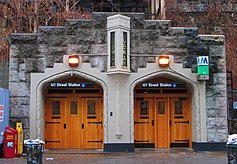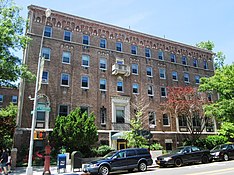Hudson Heights, Manhattan
Hudson Heights | |
|---|---|
UTC– 04:00 (EDT) | |
| ZIP Codes | 10033 and 10040 |
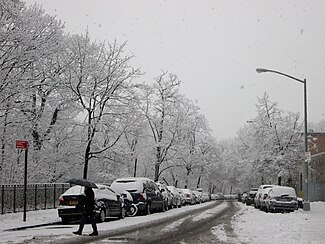
Hudson Heights is a residential neighborhood within
The neighborhood is located on a plateau[1] on top of a bluff overlooking both the Hudson River on the west and the Broadway valley of Washington Heights on the east. Hudson Heights includes the highest natural point in Manhattan, located in Bennett Park. At 265 feet (81 m) above sea level, it is a few dozen feet lower than the torch on the Statue of Liberty.[2]
At the northern end of the neighborhood, where Cabrini Boulevard meets Fort Washington Avenue at Margaret Corbin Circle, is Fort Tryon Park, conceived by John D. Rockefeller Jr., designed by the Olmsted Brothers, and given to the city by Rockefeller in 1931.[3] The park contains within it The Cloisters – also conceived of by Rockefeller – which houses the Medieval art collection of the Metropolitan Museum of Art.
Boundaries and geography
Similar to many other neighborhoods that are undergoing gentrification in New York City, this Washington Heights area was renamed by real estate brokers in the 1990s to appeal to a different type of community than was attracted to other parts of Washington Heights.[4]
Like many
Using the more restrictive boundaries, the neighborhood's main north–south thoroughfares are Fort Washington Avenue (two-way), Pinehurst Avenue (one way south) and Cabrini Boulevard (formerly Northern Avenue, one way north). Riverside Drive runs intermittently along the bottom of the ridge to the west, while Bennett Avenue and Overlook Terrace do the same on the east, with Overlook Avenue climbing to the top of the ridge at West 190th Street. The east–west streets are all numbered, from West 181st Street to West 190th Street, but none of those streets, with the exception of West 181st at the southern end of the ridge, cross all the way through the neighborhood: they are all interrupted at one point or another.[10]
History
17th century
Before European explorers and settlers, the Lenape Indians lived on the island they called Mannahatta. Just to the north of Hudson Heights, in what is now Inwood Hill Park, the Lenape tribe exchanged the island for items worth about 60 Dutch Gilders in a deal with Peter Minuit in 1626. He named the island New Amsterdam. The area north of central Manhattan was called Niew Haarlem until the British gained control of the area during the Revolutionary War. They renamed the area Lancaster, and gave it a northern border near what is now 129th Street. The ridge that overlooks the Hudson River was once inhabited by the Wecquaesgeek Indians and called Chquaesgeck. Later it was called Lange Bergh (Long Hill) by Dutch settlers until the 17th century.[3]
18th and 19th centuries
In the 18th century, only the southern portion of the island was settled by Europeans, leaving the rest of Manhattan largely untouched. Among the many unspoiled tracts of land was the highest spot on the island, which provided unsurpassed views of what would become the New York metropolitan area.[11]
When the Revolutionary War came to New York, the British had the upper hand. General George Washington and troops from his Continental Army camped on the high ground, calling it Fort Washington, to monitor the advancing Redcoats. The Continental Army retreated from its location after their defeat on November 16, 1776, in the Battle of Fort Washington.[12] The British took the position and renamed it Fort Knyphausen in honor of the leader of the Hessians, who had taken a major part in the British victory.[13] Their location was in the spot now called Bennett Park. Fort Washington had been established as an offensive position to prevent British vessels from sailing north on the Hudson River. Fort Lee, across the river, was its twin, built to assist in the defense of the Hudson Valley.[11]
Not far from the fort was the Blue Bell Tavern, located on an intersection of Kingsbridge Road, where Broadway and West 181st Street intersect today, on the southeastern corner of modern-day Hudson Heights.[14] On July 9, 1776, when New York's Provincial Congress assented to the Declaration of Independence, "A rowdy crowd of soldiers and civilians ('no decent people' were present, one witness said later) ... marched down Broadway to Bowling Green, where they toppled the statue of George III erected in 1770. The head was put on a spike at the Blue Bell Tavern ... "[14]
The tavern was later used by Washington and his staff when the British evacuated New York, standing in front of it as they watched the American troops march south to retake New York.[15]
By 1856 the first recorded home had been built on the site of Fort Washington. The Moorewood residence was there until the 1880s. The property was purchased by Richard Carman and sold to
Early to mid-20th century
At the turn of the 20th century the woods started being chopped down to make way for homes. The area was settled by Irish immigrants in the early years of the century.
The cliffs that are now
Fort Tryon
The beginning of this section of Washington Heights as a neighborhood-within-a-neighborhood seems to have started around this time, in the years before World War II. One scholar refers to the area in 1940 as "Fort Tryon" and "the Fort Tryon area." In 1989, Steven M. Lowenstein wrote, "The greatest social distance was to be found between the area in the northwest, just south of Fort Tryon Park, which was, and remains, the most prestigious section ... This difference was already remarked in 1940, continued unabated in 1970 and was still noticeable even in 1980..."[21]
Lowenstein considered Fort Tryon to be the area west of Broadway, east of the Hudson, north of West 181st Street, and south of Dyckman Street, which includes Fort Tryon Park. He writes, "Within the core area of Washington Heights (between 155th Street and Dyckman Street) there was a considerable internal difference as well. The further north and west one went, the more prestigious the neighborhood..."[21]
During World War I, immigrants from Hungary and Poland moved in next to the Irish.[22] Then, as Nazism grew in Germany, Jews fled their homeland. By the late 1930s, more than 20,000 refugees from Germany had settled in Washington Heights.[23]
Frankfurt-on-the-Hudson

In the years after
So cosmopolitan was that world that in 1934 members of the German-Jewish Club of New York started Aufbau, a newsletter for its members that grew into a newspaper. Its offices were nearby on Broadway.[26] The newspaper became known as a "prominent intellectual voice and a main forum for German Jewry in the United States," according to the German Embassy in Washington, D.C. "It featured the work of great prominent writers and intellectuals such as Thomas Mann, Albert Einstein, Stefan Zweig, and Hannah Arendt. It was one of the only newspapers to report on the atrocities of the Holocaust during World War II."[27]
In 1941 it published the Aufbau Almanac, a guide to living in the United States that explained the American political system, education, insurance law, the post office and sports.[28] After the war, Aufbau helped families that had been scattered by European battles to reconnect by listing survivors' names.[29] Aufbau's offices eventually moved to the Upper West Side. The paper nearly went bankrupt in 2006, but was purchased by Jewish Media AG, and exists today as a monthly news magazine. Its editorial offices are now in Berlin, but it keeps a correspondent in New York.[30]
When the children of the Jewish immigrants to the Hudson Heights area grew up, they tended to leave the neighborhood, and sometimes, the city. By 1960 German Jews accounted for only 16% of the population in Frankfurt-on-the-Hudson.[22] The neighborhood became less overtly Jewish into the 1970s as Soviet immigrants moved to the area.
After the Soviet immigration, families from
Late 20th and early 21st centuries
"Hudson Heights" began to be used as a name for the neighborhood around 1993.[8][33] Neighborhood activists formed a group in late 1992 to help promote the neighborhood[34] and after considering several names, settled on the one that became part of their organization's name: Hudson Heights Owners' Coalition. According to one of the group's founders, real estate brokers did not start using the name until after the group was formed.[33]
The new name replaced the outdated reference to German heritage, which some have criticized, even though the German-speaking population is negligible at best.
Elizabeth Ritter, the president of the owners' group, said, "We didn't set out to change the name of the neighborhood, but we were careful in how we selected the name of the organization."[36] In 2011, Curbed New York published on article which used Hudson Heights as an example of "How to Gentrify a Neighborhood", the first step of which was "Create a nickname to separate the area from its crime-riddled past."[37]
Today the name "Hudson Heights" has been adopted by arts organizations such as Hudson Heights Duo and the Hudson Heights String Academy, and businesses including Hudson Heights Pediatrics and Hudson Heights Restoration. Newspapers from
Demographics and real estate
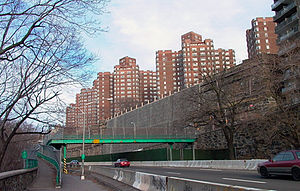
The 2010 census determined that the population of the neighborhood, using the larger definition of its boundaries, south to West 173rd Street, to be 29,000, with 44% being non-Hispanic whites, and 43% Hispanic.[8]
In 2012, the average co-op in the neighborhood sold for $388,000, while in 2013 the average price was $397,000. In 2012 166 were sold, while 244 were sold in 2013. Rents were around $1,400 per month for a studio apartment, $1,700–$2,000 for a one-bedroom apartment, and around $3,000 for a two-bedroom; prices were higher if the apartments for sublets in a co-op building.[8]
Residences
Nearly every structure was built before
The largest residential complexes in the area were started by real estate developer Dr. Charles V. Paterno; Hudson View Gardens opened in 1924 and was originally started and sold as a housing cooperative. The Tudor-style complex was designed by the architect George F. Pelham, and was listed on the National Register of Historic Places in 2016.[9] Pelham also designed The Pinehurst on Fort Washington Avenue at West 180th Street, which opened in 1908.[44] Paterno is remembered by the Paterno Trivium,[45] erected in spring 2000 at the intersection of Cabrini Boulevard, Pinehurst Avenue and West 187th Street.
Pelham's son, George F. Pelham Jr., was the architect of
Beginning in the 1980s, some rental buildings in the area started converting to housing cooperatives or condominiums. In recent years, Hudson Heights has been an attractive area for homebuyers who want to stay in Manhattan but who can't afford downtown prices, or who want larger homes than those in the rest of Manhattan.[41][48] The multiple co-ops and condos in the area formed the Hudson Heights Owners Coalition in 1993.[49]
Another large cooperative is the 16-story Cabrini Terrace at 900
Culture, food and shopping

A widely known museum in the area is The Cloisters in Fort Tryon Park, where the Metropolitan Museum of Art houses and displays its collection of Medieval art. In September, the park hosts the Medieval Festival, a free fair with costumed revelers, food and music.[52] In its September 2007 issue, Gourmet described the Dominican restaurants in Washington Heights and Inwood, including many in Hudson Heights.[42]
Hudson Heights is among the neighborhoods of Upper Manhattan that participate in The Art Stroll, an annual festival of the arts which highlights local artists. Public places in Washington Heights, Inwood and Marble Hill host impromptu galleries, readings, performances and markets over several weeks each summer.[53]
Bennett Park is the location of the highest natural point in Manhattan, as well as a commemoration on the east side of the park of the walls of
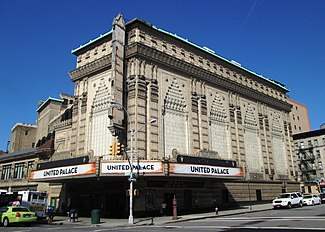
Many small shops are located on West 181st Street at the southern end of the neighborhood, and all along Broadway near to its border. In the middle of the neighborhood itself, there is a small shopping area at
News of Upper Manhattan is published weekly in The Manhattan Times, a bilingual newspaper. Its annual restaurant guide, highlights the area's burgeoning restaurant scene. Events are also listed in the Washington Heights & Inwood Online calendar.[54]
Nearby to Hudson Heights lies the
Police and crime
Hudson Heights, along with Inwood, is patrolled by the 34th Precinct of the NYPD, located at 4295 Broadway.[61] The 34th Precinct ranked 23rd safest out of 69 patrol areas for per-capita crime in 2010.[62]
The 34th Precinct has a lower crime rate than in the 1990s, with crimes across all categories having decreased by 86.3% between 1990 and 2018. The precinct reported 1 murder, 27 rapes, 200 robberies, 315 felony assaults, 155 burglaries, 592 grand larcenies, and 87 grand larcenies auto in 2018.[63]
Fire safety
Hudson Heights is served by the New York City Fire Department (FDNY)'s Engine Company 93/Ladder Company 45/Battalion 13, located at 515 West 181st Street.[64][65]
Post office and zip codes

Hudson Heights is located in two ZIP Codes. The area south of 187th Street is part of 10033 while the area north of 187th Street is part of 10040.[66]
The United States Postal Service operates two post offices near Washington Heights: the Washington Bridge Station at 518 West 181st Street[67] and the Ft George Station at 4558 Broadway.[68]
Religion
The
The
Washington Heights is also the home of Khal Adath Jeshurun (KAJ or "Breuer's"), the German-Jewish Ashkenazi congregation established in the late 1930s.[80] The congregation maintains the German-Jewish mode of worship, its liturgy, practices, and distinctive melodies. There are several educational institutions associated with KAJ as well.
Other churches and synagogues in the area include Our Saviour's Atonement Lutheran Church; Congregation Mount Sinai Anshe; Uptown Community Church; Beth Am, The People's Temple; Fort Washington Collegiate Church; Fort Tryon Jewish Center; Holyrood Church; and Congregation Shaare Hatikvah Ahavath Torah v'Tikvoh Chadoshoh.
Education
Schools
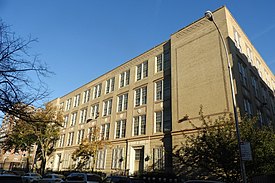
For grades kindergarten through 8, Hudson Heights is zoned to the New York City Department of Education's P.S./I.S. 187 Hudson Cliffs; it had 796 students as of the 2016–2017 school year.[update][81] In 2013, 43% of the school's third grade students met state standards in English, as opposed to 28% in the entire city.[8] The School Quality Snapshot of 2016–17 showed that 51% of the school's students met the state's standards in both English and Math, which compares favorably to citywide figures of 41% in English and 38% in Math.[9]
Another public school in the extended definition of the neighborhood is P.S. 173, located on Fort Washington Avenue between West 173 and 174th Streets, which includes grades pre-K through 5. P.S. 173's state test scores show that 34% met state standards in English, as opposed to 40% citywide, and 37% met the Math standards, compared to 42% in the city as a whole.[9]
Also located in the neighborhood was the Roman Catholic
Private schools in the general area, including nearby Inwood, include Osher Early Learning Center;[84] the Medical Center Nursery School;[85] the YM/YWHA of Washington Heights and Inwood Nursery School;[86] and the City College Academy of the Arts,[87] a project funded by the Bill & Melinda Gates Foundation.[8]
Library
The nearest New York Public Library (NYPL) branch is the Fort Washington branch, located at 535 West 179th Street. The three-story Carnegie library opened in 1979.[88]
Hospitals
The neighborhood has no local hospitals. The former St. Elizabeth's Hospital at 689 Fort Washington Avenue at
Transportation
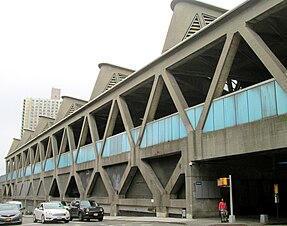
Both of the subway entrances in Hudson Heights are notable. The subway entrance at Fort Washington Avenue and West 193rd Street, which leads to the
Both of the stations provide
The
The George Washington Bridge, visible for miles from its entrance at 179th Street, earns this accolade from the noted architect Le Corbusier:
The George Washington Bridge over the Hudson is the most beautiful bridge in the world. Made of cables and steel beams, it gleams in the sky like a reversed arch. It is blessed. It is the only seat of grace in the disordered city.[93]
Beneath the bridge, at the east stanchion, is the Little Red Lighthouse, where a namesake festival is held is in the late summer, and where a 5.85-mile (9.41 km) recreational swim finishes in early autumn.[94] It is also a popular place to watch for peregrine falcons[95] and the monarch butterfly migration.[96]
Streets
The primary north–south streets in Hudson Heights are:
- Fort Washington Avenue – named after Fort Washington, the last fortified position of the Continental Army in New York before the city was taken over by the British in the American Revolutionary War.[97]
- Pinehurst Avenue – named after "Pinehurst", the estate of sheepskin manufacturer C. P. Bucking[98][17]
- Roman Catholic Church.[79]
- Overlook Terrace – which runs at the bottom of the ridge from West 190th to 184th Street, was named for the view at the top of the street, before it descends[99]
- Bennett Avenue – which runs at the bottom of the ridge east of Overlook Terrace from Nagle Avenue to West 181st Street. It was named after James Gordon Bennett, Sr., who founded the New York Herald newspaper. His name is also enshrined on Bennett Park in the heart of the neighborhood.[100]
Other named or co-named streets in the neighborhood include:
- Alex Rose Place (West 186th Street between Chittenden Avenue and Cabrini Boulevard) – Fiorello H. LaGuardia and John Lindsay to reach office as Mayors of New York City. Rose lived at 200 Cabrini Boulevard nearby.[101]
- Chittenden Avenue – named in 1911 after Lucius Chittendon, a merchant from Palisades.
- Colonel Robert Magaw Place – named after Col. Robert Magaw, a lawyer from Philadelphia who commanded the American forces in Fort Washington during the Battle of Fort Washington. The street runs for two blocks from West 181st to 183rd Streets, east of Fort Washington Avenue and west of Bennett Avenue.[103]
- Jacob Birnbaum Way (portion of Cabrini Boulevard at West 187th Street) – named after Jacob Birnbaum, a human rights advocate born in Germany, and the founder in 1964 of Student Struggle for Soviet Jewry, as well as other organizations. He lived at Cabrini and West 187th Street. The section of street was named after him on October 18, 2015.[104]
- Margaret Corbin Circle and Margaret Corbin Drive – The circle is outside the main entrance to Fort Tryon Park, while the drive runs from there through the park to the Henry Hudson Parkway. Both are named after Margaret Corbin, a heroine of the American Revolution who took her husband's place in a cannon crew after he was killed,[105] and subsequently the first female pensioner of the United States. Her annual pension was a suit of clothes and cash equivalent to the cost of a half-pint of liquor.[106]
- Paterno Trivium (intersection of Cabrini Boulevard, Pinehurst Avenue and West 187th Street) – named after Dr. Charles V. Paterno, a dentist-turned-real estate developer who built the Hudson View Gardens cooperative complex, and lived in a mansion known as "Paterno's Castle", on the site of what is now Castle Village, another one of his developments. The Trivium – Latin for the meeting of three streets – was designed by architect Thomas Navin, and was designated part of the New York City Department of Parks and Recreation's "Greenstreets" program in 2000. It was formally dedicated on August 4, 2001, the birth date of Dr. Paterno. It features a small garden and benches for sitting.[107][108]
- Marquis de Lafayette, the French hero of the American Revolution, and this small plaza retains the name.[109] An overlook on the west end of the plaza features views of the Henry Hudson Parkway, the George Washington Bridge, the Hudson River, and the Palisades.
Parks
Parks in Hudson Heights include:

- Fort Tryon Park – a large, 67 acres (27 ha) park assembled by John D. Rockefeller Jr., designed by the Olmsted Brothers and presented to the city in 1931. It is the site of The Cloisters, which houses the Medieval art collection of the Metropolitan Museum of Art.
- Fort Washington during the Revolutionary War, is a neighborhood park named after James Gordon Bennett Sr., the publisher of the New York Herald. It is the location of the highest natural point in Manhattan.
- J. Hood Wright Park – which is included in the extended definition of the neighborhood, is located between Fort Washington and Haven Avenues, and between West 173rd and 176th Streets. It is a neighborhood park named for James Hood Wright, a banker, financier and philanthropist, and includes a recreation center.
- Fort Washington Park – runs along the Hudson River from West 155th Street to Dyckman Street, under the George Washington Bridge. It includes the Little Red Lighthouse.
Notable residents
Notable current and former residents of Hudson Heights include:

- C. K. G. Billings, industrialist, avid horseman and eccentric tycoon; his estate, Tryon Hall, formed the basis for Fort Tryon Park
- Jacob Birnbaum, activist for the rights of Soviet Jews[104]
- Rabbi Joseph Breuer, religious leader[110]
- Mother Francesca Saverio Cabrini, missionary, saint, and namesake of the neighborhood High School, Shrine, Boulevard and Woods[111]
- Laurence Fishburne, actor[112]
- Scott Goldstein, writer, producer, director
- Henry Kissinger (born 1923), diplomat and statesman[113]
- Daniel D. McCracken, early computer pioneer, City College of New York professor, and author
- Lin-Manuel Miranda, playwright, actor, and musician, owns two co-op units in the Castle Village complex in Hudson Heights.[114]
- Charles V. Paterno, a doctor who became a real estate developer, he built Hudson View Gardens and Castle Village, two of the largest complexes in the neighborhood, the latter on the site of his own mansion, which was known as "Paterno's Castle".[107][108] The Paterno Trivium at the intersection of Cabrini Boulevard, Pinehurst Avenue and West 187th Street is named for him.[115]
- Alex Rose, labor leader[101]
- James R. Russell, scholar of Ancient Near Eastern, Iranian and Armenian Studies, and Harvard University professor
- Rabbi Shimon Schwab, religious leader[116]
- Dr.
In popular culture
The 1985 film
Gallery
-
The Fort Tryon Park Cottage is a remnant of one of the estates which abounded in the area
-
Nine flights of stairs connect Overlook Terrace and Fort Washington Avenue atWest 187th Street
-
The181st Streetsubway entrance between West 183rd and 185th Streets provides elevators which lead to...
-
...the entrance at 184th Street and Overlook Terrace in the Broadway valley of Washington Heights below
-
The former St. Elizabeth's Hospital is now cooperative apartments
-
The entrance to 186-196 Pinehurst Avenue
References
Informational notes
- Community Boards, whose boundaries are officially set, but these are fairly large and generally contain a number of neighborhoods, and the neighborhood mapissued by the Department of City Planning only shows the largest ones.) Because of this, the definition of where neighborhoods begin and end is subject to a variety of forces, including the efforts of real estate concerns to promote certain areas, the use of neighborhood names in media news reports, and the everyday usage of people.
Citations
- ^ Orenstein, Sidney (February 27, 2017) "The Geology of Northern Manhattan" (lecture)
- New York City Parks and Recreation Departmentwebsite. Retrieved June 22, 2010.
- ^ ISBN 978-0-300-11465-2.
- ^ a b Staff (September 17, 2001) "Manhattan apartments at a discount: Hudson Heights" New York
- ^ Harris, Elizabeth A. (October 16, 2009) Map included in "An Aerie Straight Out of the Deco Era" The New York Times. Retrieved June 22, 2010.
- ^ Wisloski, Jess (February 14, 2004) "Close-Up on Hudson Heights" The Village Voice. Retrieved June 22, 2010.
- ^ "Hot Guide 2009. Hudson Heights: 173rd Street to Fort Tryon Park, West of Broadway" Archived July 12, 2011, at the Wayback Machine Retrieved June 22, 2010.
- ^ a b c d e f g Hughes, C. L. (October 15, 2014) "Affordable Manhattan in Hudson Heights" The New York Times
- ^ a b c d Jacobsen, Aileen (March 28, 2018) "Living In: Hudson Heights: A Hidden Gem, Gaining Popularity" The New York Times
- New York City Department of Information Technology and Telecommunications. Retrieved March 20, 2020.
- ^ a b Burrows & Wallace (1999), p.448
- ^ "The Battle of Fort Washington, Revolutionary War" Archived February 13, 2010, at the Wayback Machine on AmericanRevolution.org
- ^ Jenkins, Stephen (1911) The Greatest Street in the World: The Story of Broadway, Old and New, from the Bowling Green to Albany, New York: G. P. Putnam's Sons. p.36
- ^ a b Burrows & Wallace (1999), p.232
- ^ a b c Renner, James (2007) Images of America: Washington Heights, Inwood, and Marble Hill. Charleston, South Carolina: Arcadia Publishing.
- ^ a b c Feirstein, p.170
- ^ a b Norcross, Frank Wayland (1901) A History of the New York Swamp Chiswick Press. p.208
- ^ Staff (January 4, 1917) "C.K.G. Billings Sells Famous Tryon Hall: Prominent New Yorker, Whose Name is Withheld, Buys Riverside Drive Estate; Mansion Cost $2,000,000 – Built on Site of Fort of Revolutionary Frame, the House is One of New York's Show Places", The New York Times p.22. Accessed June 4, 2009
- ^ Renner, James. "C.K.G. Billings" Archived April 18, 2003, at the Wayback Machine, on the Hudson Heights Owners Coalition website Accessed June 4, 2009.
- ^ Van Dine, S.S. (1934) The Dragon Murder Case. New York: Charles Scribner's.
- ^ a b c Lowenstein (1989), pp.42–44
- ^ a b Bennet, James (August 27, 1992) "The Last of Frankfurt-on-the-Hudson: A Staunch, Aging Few Stay On as Their World Evaporates" The New York Times
- ^ Lowenstein (1989), p.18
- ^ New York Sun
- ^ Ressig, Volker. Frankfurt on the hudson, oder: Die Liebe für Amerika, die Sehnsucht für Europa Archived December 2, 2005, at the Wayback Machine (Trans.: "Frankfurt on the Hudson, Or: The love for America, the longing for Europe.") Körber-Stiftung.
- ^ "Inwood/Washington Heights" Archived October 26, 2015, at the Wayback Machine Immigrant Heritage Trail
- ^ "A Jewish Journal Reborn in Berlin" Archived November 21, 2006, at the Wayback Machine German Embassy in Washington, D.C
- ^ Lowenstein (1989), p.51
- ^ Blake, Maria (July/August 2008) "Second Life." Columbia Journalism Review, Vol. XLVII, No. 2, p.12.
- ^ Aufbau, Das Jüdische Monatsmagazin
- ^ "Washington Heights" Columbia 250
- ^ White, et al., p.571
- ^ a b Calabi, Marcella and Ritter, Elizabeth Lorris (October 29, 2010) "How Hudson Heights Got Its Name" Archived August 18, 2011, at the Wayback Machine Hudson Heights Guide
- ^ Garb, Maggi (November 8, 1998) "If You're Thinking of Living In Hudson Heights: High Above Hudson, a Crowd of Co-ops", The New York Times
- ^ "Profile of Selected Social Characteristics: 2000; Census Tract 273, New York County, New York, Language Spoken at Home" Archived February 12, 2020, at archive.today United States Census Bureau. Accessed June 4, 2009; and "Profile of Selected Social Characteristics: 2000; Census Tract 275, New York County, New York, Language Spoken at Home" Archived February 12, 2020, at archive.today United States Census Bureau Accessed June 4, 2009
- ^ Harris, Elizabeth A. (October 16, 2009) "Living in Hudson Heights: An Aerie Straight Out of the Deco Era". The New York Times Accessed March 7, 2010.)
- ^ Arak, Joey (April 8, 2011) "How to Gentrify a Neighborhood: Just Study Hudson Heights" Curbed New York
- ^ Mokha, Kavita Mokha (April 8, 2011) "Hudson Heights Pumps More-for-Less Theme" The Wall Street Journal. Accessed April 13, 2011.
- ^ Eligon, John (April 22, 2008) "In Hudson Heights, A Bid to Keep the Economy's Woes from Becoming Their Own", The New York Times. Accessed June 4, 2009.
- ^ Schlesinger, Toni (January 1, 2002) "NY Mirror: Studio in Hudson Heights", The Village Voice. Accessed June 4, 2009.
- ^ Money
- ^ Gourmet. Accessed June 4, 2009.
- ^ Platt, Russell (May 16, 2016) "Romanesque Riffs" The New Yorker. Accessed May 28, 2016.
- ^ "History of The Pinehurst" Archived March 9, 2016, at the Wayback Machine on Pinehurst Co-Operative Apartments website. Retrieved May 28, 2016
- New York City Parks and Recreation Departmentwebsite
- ^ "NYC Department of Buildings Inquiry Report: Castle Village Retaining Wall Collapse April 2007" Archived May 24, 2011, at the Wayback Machine New York City Department of Buildings website Retrieved June 23, 2010
- ^ Solomonow, Seth (February29, 2008) "181st Street Ramp to Reopen on Saturday, March 1" New York City Department of Transportation. Accessed June 4, 2009.
- New York Times, Section 11, p.6. Accessed June 4, 2009.
- ^ Hudson Heights Owners Coalition. Accessed June 4, 2009.
- ^ "Cabrini Terrace Cooperative Apartments" Archived May 5, 2006, at the Wayback Machine on the Hudson Heights Owners Coalition website (December 23, 1999) Retrieved April 4, 2008.
- ^ Dwyer, James (January 23, 2008) "(Solar) Power to the People Is Not So Easily Achieved" The New York Times. Retrieved April 4, 2008
- ^ The 2007 Medieval Festival in Fort Tryon Park, The Washington Heights and Inwood Development Corporation Archived September 10, 2004, at the Wayback Machine
- ^ Uptown Art Stroll website Accessed June 4, 2009
- ^ "Calendar" Archived December 21, 2014, at the Wayback Machine on Washington Heights & Inwood Online
- ^ Adams, Nathaniel (January 15, 2015). "Across the New York Area, Restoring 'Wonder Theater' Movie Palaces to Glory". The New York Times.
- ^ .Dunlap, David W. (April 13, 2001), "Xanadus Rise to a Higher Calling", The New York Times
- ^ Atamian, Christopher (November 11, 2007). "'Rite of Spring' as Rite of Passage". The New York Times.
- ISBN 0-231-12543-7., p.286
- ^ Lehman-Haupt, Christopher. (July 30, 2009) "Reverend Ike, Who Preached Riches, Dies at 74" The New York Times
- ^ Staff (December 13, 2016) "LPC Backlog Initiative Results in 27 New Landmarks" (press release) New York City Landmarks Preservation Commission
- ^ "NYPD – 34th Precinct". www.nyc.gov. New York City Police Department. Retrieved October 3, 2016.
- ^ "Inwood – DNAinfo.com Crime and Safety Report". www.dnainfo.com. Archived from the original on December 30, 2016. Retrieved October 6, 2016.
- ^ "34th Precinct CompStat Report" (PDF). www.nyc.gov. New York City Police Department. Retrieved July 22, 2018.
- ^ "Engine Company 93/Ladder Company 45/Battalion 13". FDNYtrucks.com. Retrieved March 14, 2019.
- ^ "FDNY Firehouse Listing – Location of Firehouses and companies". NYC Open Data; Socrata. New York City Fire Department. September 10, 2018. Retrieved March 14, 2019.
- ^ "Washington Heights, New York City-Manhattan, New York Zip Code Boundary Map (NY)". United States Zip Code Boundary Map (USA). Retrieved March 26, 2019.
- ^ "Location Details: Washington Bridge". USPS.com. Retrieved March 7, 2019.
- ^ "Location Details: Fort George". USPS.com. Retrieved March 7, 2019.
- ^ a b Hebrew Tabernacle Bulletin, January–February 2019
- ^ Sibylle Quack (2002). Between Sorrow and Strength; Women Refugees of the Nazi Period, Cambridge University Press.
- ^ Moses Rischin, Raphael Asher (1991). The Jewish Legacy and the German Conscience; Essays in Memory of Rabbi Joseph Asher
- ^ a b David W. Dunlap (2004). From Abyssinian to Zion; A Guide to Manhattan's Houses of Worship, Columbia University Press.
- ^ Norval White, Elliot Willensky, Fran Leadon (2010). AIA Guide to New York City, Oxford University Press.
- ^ Robert W. Snyder (2014).Crossing Broadway; Washington Heights and the Promise of New York City, Cornell University Press.
- ^ Kerry M. Olitzky, Marc Lee Raphael (1996). The American Synagogue; A Historical Dictionary and Sourcebook
- ^ Steven M. Lowenstein (1989). Frankfurt on the Hudson; The German-Jewish Community of Washington Heights, 1933–1983, Its Structure and Culture, Wayne State University Press.
- ^ "Hebrew Tabernacle Marking 75th Anniversary". The New York Times. May 2, 1982.
- ^ Crowns, Crosses, and Stars; My Youth in Prussia, Surviving Hitler, and a Life Beyond
- ^ a b Moscow, p. 38
- ^ "History" Archived September 18, 2011, at the Wayback Machine on the Khal Adath Jeshrun website. Accessed August 31, 2001
- ^ "P.S./I.S. 187 Hudson Cliffs – M187". New York City Department of Education. Retrieved March 8, 2017.
- DNAinfo New York
- ^ Feeney, Michael J. (May 22, 2014) "Upper Manhattan parents fuming over Success Academy securing a school building in their district" New York Daily News
- ^ See the Osher Early Learning Center website
- ^ See the Medical Center Nursery School website
- ^ See the YM/YWHA of Washington Heights and Inwood Nursery School website
- ^ See the City College Academy of the Arts Archived December 18, 2014, at the Wayback Machine website
- ^ "About the Fort Washington Library". The New York Public Library. Retrieved March 23, 2019.
- ^ a b Guided tour (October 11, 2014) Fort Tryon Park Cottage
- ^ "The Deepest and Highest Subway Stations in NYC: 191st St, 190th Street, Smith & 9th" on Untapped Cities (June 26, 2013)
- Forgotten New York
- ^ White et al., p.570
- ^ Corbusier, Le (1947) Le Corbusier in America: When the Cathedrals were White New York: Reynal and Hitchcock.
- ^ "Little Red Lighthouse Swim, Manhattan Island Foundation". Archived from the original on September 8, 2012.
- ^ "Fort Washington Park: Peregrine Falcons in New York City", New York City Department of Parks and Recreation website
- ^ "Monarch Butterflies In New York City" Informational marker in Fort Washington Park
- ^ Moscow, p.51
- ^ Moscow, p.84
- ^ Moscow, p.80
- ^ Moscow, p.28
- ^ a b Feirstein, p.169
- ^ Moscow, p.38
- ^ Moscow, p.71
- ^ a b Zalman, Jacob (October 23, 2015) Jonathan Zalman, "New York City Street Dedicated to Soviet Jewish Activist Jacob Birnbaum" The Tablet
- ^ Moscow, p.75
- ^ Feirstein, p.173
- ^ a b Parks Department informational sign on site. Accessed: March 8, 2017
- ^ a b "Greenstreet: Highlights – Paterno Trivium" New York City Department of Parks and Recreation website
- ^ Feirstein, p.174
- ^ Bodenheimer, Dr. Ernst J. with Scherman, Rabbi Nosson (April 27, 2009) "Rabbi Yoseph Breuer: The Rav of Frankfurt, U.S.A., On His 29th Yahrtzeit, Today, 3 Iyar" matzav.com
- ^ Luongo, Michael (February 6, 2015) "In Upper Manhattan, Restoring the Golden Halo of Mother Cabrini" The New York Times
- ^ Staff (March 7, 2008) "Hudson Heights delivers", New York Daily News Accessed March 20, 2008
- ISBN 0674025792. p.44
- ^ "Lin-Manuel Miranda Reveals Location of His First Post-College NYC Apartment | StreetEasy". November 5, 2018.
- ^ "GREENSTREET Highlights – Paterno Trivium : NYC Parks". www.nycgovparks.org.
- ISBN 1-57819-512-8.
- ^ Morris, Bob. (December 21, 1995) "At Home With: Dr. Ruth Westheimer; The Bible as Sex Manual?" The New York Times
- ^ Canby, Vincent (August 27, 1986) "Film Review: 'We Were So Beloved'" The New York Times
- ^ "In the Heights" Archived August 12, 2014, at the Wayback Machine on the Internet Off-Broadway Database
- ^ "In the Heights" on the Internet Broadway Database
- ^ "Columbia University School of Journalism, Pulitzer Prizes for Letters". Accessed June 4, 2009
Bibliography
- ISBN 0-195-11634-8.
- Feirstein, Sanna (2001). Naming New York: Manhattan Places & How They Got Their Names. New York: ISBN 978-0-8147-2712-6.
- Lowenstein, Steven M. (1989) Frankfurt on the Hudson: The German Jewish Community of Washington Heights, 1933–1983, Its Structure and Culture Detroit: Wayne State University Press. ISBN 0814319602
- Moscow, Henry (1978). The Street Book: An Encyclopedia of Manhattan's Street Names and Their Origins. New York: ISBN 978-0-8232-1275-0.
- ISBN 978-0-19538-386-7.
External links
 Media related to Hudson Heights, Manhattan at Wikimedia Commons
Media related to Hudson Heights, Manhattan at Wikimedia Commons







